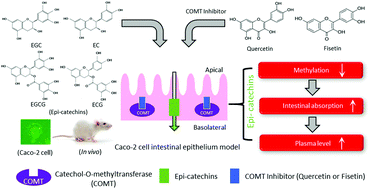Quercetin and fisetin, known as catechol-containing flavonoids, could positively affect the absorption of catechins due to their strong affinity for catechol-O-methyl transferase (COMT), which can methylate and cause the excretion of catechins. The current study examined the effect of quercetin and fisetin on the absorption of epi-catechins (ECs) by using a Caco-2 cell line and an in vivo model. The intestinal transport of total catechins by Caco-2 cells was enhanced from 1.3- to 1.6-fold and 1.4- to 1.7-fold by adding quercetin and fisetin, respectively, compared to the control. It was even higher in the treatment with a mixture of quercetin and fisetin. While EC had the highest value of intestinal transport (169% of the control) in 10% quercetin treatment, EGC (235%), EGCG (244%), and ECG (242%) were significantly transported in the treatment with a 5% mixture of quercetin and fisetin (p < 0.05). In an in vivo pharmacokinetic study, the values of the area under the plasma concentration–time curve (AUC, ng h mL−1) were also higher in rats orally administered EGCG with 10% quercetin (365.5 ± 25.5) or 10% fisetin (825.3 ± 46.7) than in those administered EGCG only (111.3 ± 13.1). Methylated quercetin and methylated fisetin were determined to be m/z 317.24 and m/z 301.25 [M + H]+ with their own product ions, respectively. The results indicate that quercetin or fisetin is superior to ECs for methylation by COMT.

